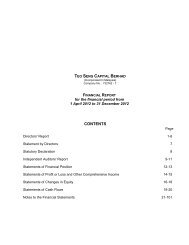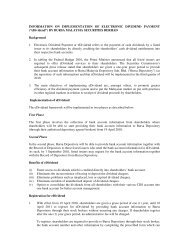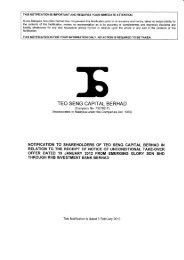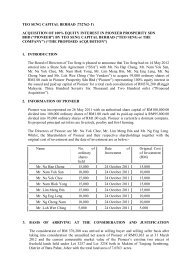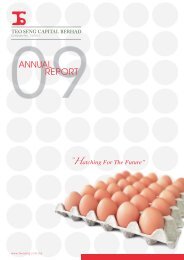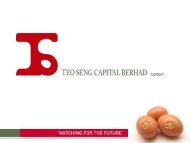Hatching For The Future - teo seng capital berhad
Hatching For The Future - teo seng capital berhad
Hatching For The Future - teo seng capital berhad
Create successful ePaper yourself
Turn your PDF publications into a flip-book with our unique Google optimized e-Paper software.
Teo Seng Capital Berhad<br />
Notes To <strong>The</strong> Financial Statements<br />
<strong>For</strong> <strong>The</strong> Financial Year Ended 31 March 2012<br />
4.<br />
ACCOUNTING POLICIES AND STANDARDS (cont’d)<br />
4.6<br />
Critical Accounting Estimates and Judgements<br />
Estimates and judgements are continually evaluated by the directors and management and are based on historical<br />
experience and other factors, including expectations of future events that are believed to be reasonable under the<br />
circumstances. <strong>The</strong> estimates and judgements that affect the application of the Group’s accounting policies and<br />
disclosures, and have a significant risk of causing a material adjustment to the carrying amounts of assets,<br />
liabilities, income and expenses are discussed below :<br />
(a)<br />
Depreciation of property, plant and equipment<br />
<strong>The</strong> estimates for the residual values, useful lives and related depreciation charges for the property, plant and<br />
equipment are based on commercial factors which could change significantly as a result of technical<br />
innovations and competitors’ actions in response to the market conditions.<br />
<strong>The</strong> Group anticipates that the residual values of its property, plant and equipment will be insignificant. As a<br />
result, residual values are not being taken into consideration for the computation of the depreciable amount.<br />
Changes in the expected level of usage and technological development could impact the economic useful<br />
lives and the residual values of these assets, therefore future depreciation charges could be revised.<br />
(b)<br />
Income tax<br />
<strong>The</strong>re are certain transactions and computations for which the ultimate tax determination may be different<br />
from the initial estimate. <strong>The</strong> Group recognises tax liabilities based on its understanding of the prevailing tax<br />
laws and estimates of whether such taxes will be due in the ordinary course of business. Where the final tax<br />
outcome of these matters is different from the amounts that were initially recognised, such difference will<br />
impact the income tax and deferred tax provisions, in the year in which such determination is made.<br />
(c)<br />
Impairment of non-financial assets<br />
When the recoverable amount of an asset is determined based on the estimate of the value-in-use of the<br />
cash-generating unit to which the asset is allocated, the management is required to make an estimate of the<br />
expected future cash flows from the cash-generating unit and also to apply a suitable discount rate in order to<br />
determine the present value of those cash flows.<br />
(d)<br />
Write-down of inventories – Non-livestocks<br />
Reviews are made periodically by management on damaged, obsolete and slow moving inventories. <strong>The</strong>se<br />
reviews require judgement and estimates. Possible changes in these estimates could result in revisions to the<br />
valuation of inventories.<br />
(e)<br />
Classification between investment property and owner-occupied properties<br />
<strong>The</strong> Group determines whether a property qualifies as an investment property, and has developed a criteria in<br />
making that judgement. Investment property is a property held to earn rentals or for <strong>capital</strong> appreciation or<br />
both. <strong>The</strong>refore, the Group considers whether a property generates cash flows largely independent of the<br />
other assets held by the Group.<br />
Some properties comprise a portion that is held to earn rentals or for <strong>capital</strong> appreciation and another portion that<br />
is held for use in the production or supply of goods or services or for administrative purposes. If these portions<br />
could be sold separately (or leased out separately under a finance lease), the Group accounts for the portions<br />
separately. If the portions could not be sold separately, the property is an investment property only if an<br />
insignificant portion is held for use in the production or supply of goods or services or for administrative purposes.<br />
Annual Report 2012<br />
Judgement is made on an individual property basis to determine whether ancillary services are so significant<br />
that a property does not qualify as investment property.<br />
59



